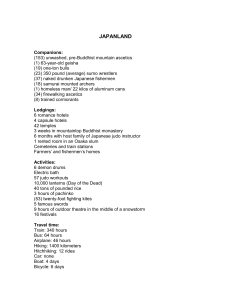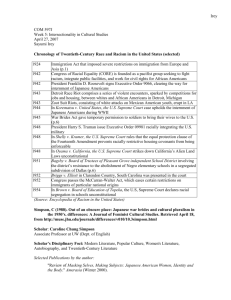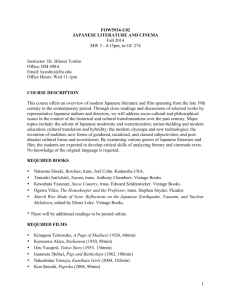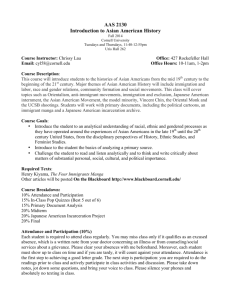Course Syllabus - Hironori Sasada
advertisement
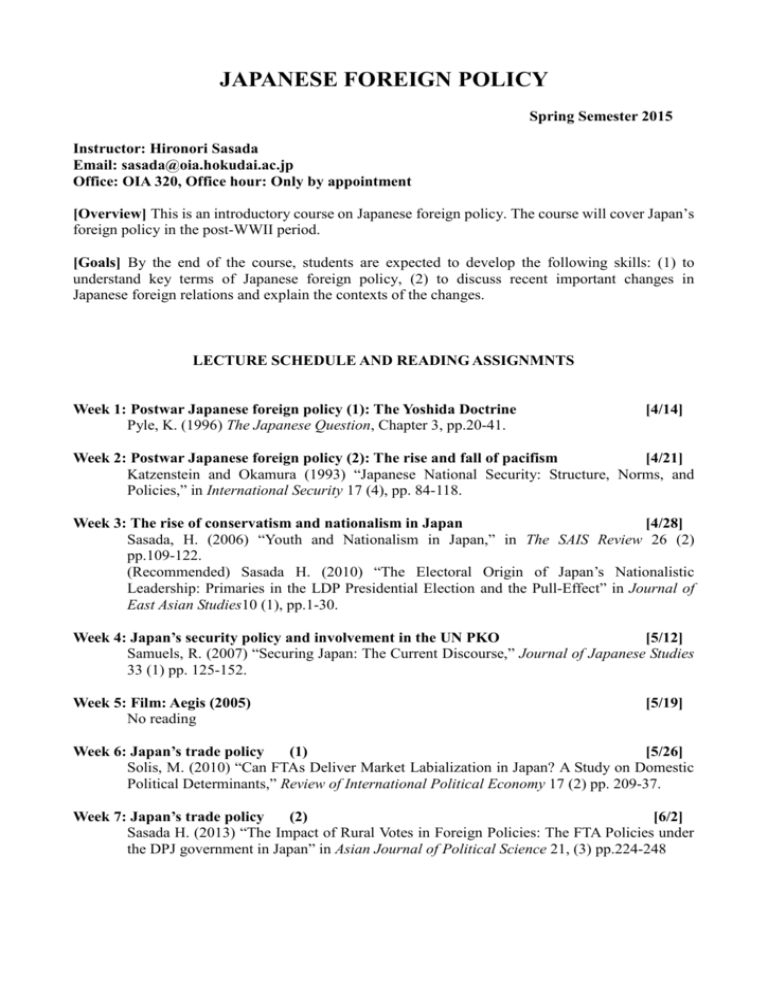
JAPANESE FOREIGN POLICY Spring Semester 2015 Instructor: Hironori Sasada Email: sasada@oia.hokudai.ac.jp Office: OIA 320, Office hour: Only by appointment [Overview] This is an introductory course on Japanese foreign policy. The course will cover Japan’s foreign policy in the post-WWII period. [Goals] By the end of the course, students are expected to develop the following skills: (1) to understand key terms of Japanese foreign policy, (2) to discuss recent important changes in Japanese foreign relations and explain the contexts of the changes. LECTURE SCHEDULE AND READING ASSIGNMNTS Week 1: Postwar Japanese foreign policy (1): The Yoshida Doctrine Pyle, K. (1996) The Japanese Question, Chapter 3, pp.20-41. [4/14] Week 2: Postwar Japanese foreign policy (2): The rise and fall of pacifism [4/21] Katzenstein and Okamura (1993) “Japanese National Security: Structure, Norms, and Policies,” in International Security 17 (4), pp. 84-118. Week 3: The rise of conservatism and nationalism in Japan [4/28] Sasada, H. (2006) “Youth and Nationalism in Japan,” in The SAIS Review 26 (2) pp.109-122. (Recommended) Sasada H. (2010) “The Electoral Origin of Japan’s Nationalistic Leadership: Primaries in the LDP Presidential Election and the Pull-Effect” in Journal of East Asian Studies10 (1), pp.1-30. Week 4: Japan’s security policy and involvement in the UN PKO [5/12] Samuels, R. (2007) “Securing Japan: The Current Discourse,” Journal of Japanese Studies 33 (1) pp. 125-152. Week 5: Film: Aegis (2005) No reading [5/19] Week 6: Japan’s trade policy (1) [5/26] Solis, M. (2010) “Can FTAs Deliver Market Labialization in Japan? A Study on Domestic Political Determinants,” Review of International Political Economy 17 (2) pp. 209-37. Week 7: Japan’s trade policy (2) [6/2] Sasada H. (2013) “The Impact of Rural Votes in Foreign Policies: The FTA Policies under the DPJ government in Japan” in Asian Journal of Political Science 21, (3) pp.224-248 Week 8: Midterm Exam [6/9] Week 9: US-Japan political relations Hayes, L. (2008) Chapter 12 (pp.239-253) [6/16] Week 10: US-Japan economic relations [6/23] Schoppa, L. (1993) “Two-level Games and Bargaining Outcomes: Why Gaiatsu Succeeds in Japan in Some Cases but Not Others”, International Organization 47 (3), pp. 353-86. Week 11: Japan’s economic relationship with Asia [6/30] Hatch, W. and K. Yamamura. (1995) Asia in Japan's Embrace: Building a Regional Production Alliance, pp.20-40. Week 12: Japan’s political relationship with Asia (1) TBA [7/7] Week 13: Japan’s political relationship with Asia (2) [7/14] Shibuichi, D. (2005) “The Yasukuni Shrine Dispute and the Politics of Identity in Japan: Why All the Fuss?” in Asian Survey 45 (2), pp.197-215. Week 14: Japan’s involvement in international organizations [7/21] Pekkanen, S. (2004) “The Politics of Japan’s WTO Strategies,” Orbis 48 (1), pp.135-47. Week 15: Final exam [7/28] Class participation Your participation score depends on your active participation in class discussion. Just attending the lectures DOES NOT help your score much. You need to get involved in class discussion (make comments, ask questions, etc.). In order to do so, you need to read the assigned materials and prepare well for the lecture. Also, if you miss 5 lectures or more, you will fail this course. Reading materials All reading materials will be made available online at the course website (www.hironori-sasada.net). You will need a password to access the materials. Download the files and read them before the lectures. Password: ______________ Grade Midterm exam Final exam Class participation 40% 40% 20%





